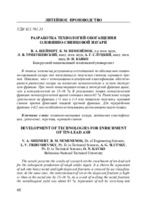| dc.contributor.author | Шейнерт, В. А. | ru |
| dc.contributor.author | Неменёнок, Б. М. | ru |
| dc.contributor.author | Трибушевский, Л. В. | ru |
| dc.contributor.author | Слуцкий, А. Г. | ru |
| dc.contributor.author | Кавко, О. Н. | ru |
| dc.coverage.spatial | Минск | ru |
| dc.date.accessioned | 2023-04-28T13:40:37Z | |
| dc.date.available | 2023-04-28T13:40:37Z | |
| dc.date.issued | 2023 | |
| dc.identifier.citation | Разработка технологий обогащения оловянно-свинцовой изгари = Development of technologies for enrichment of tin-lead ash / В. А. Шейнерт [и др.] // Металлургия : республиканский межведомственный сборник научных трудов / редкол.: И. А. Иванов [и др.]. – Минск : БНТУ, 2023. – Вып. 43. – С. 68-79. | ru |
| dc.identifier.uri | https://rep.bntu.by/handle/data/127493 | |
| dc.description.abstract | В статье изложены результаты исследований по обогащению оловянно-свинцовой изгари для последующего получения слитков чернового припоя. Показано, что с использованием воздушной классификации обеспечивается разделение изгари на тяжелую металлическую и легкую дисперсную фракции. При этом концентрация олова в дисперсной фракции выше, чем в металлической на 15–16 %. В результате плавки металлической фракции металлургический выход составил около 65 %. Разделение изгари грохочением на фракции (+5 мм) и (–5 мм) позволило получить черновой слиток припоя флюсовой плавкой крупной фракции. Для переработки фракции (–0,5 мм) необходимо использовать восстановительную плавку. | ru |
| dc.language.iso | ru | ru |
| dc.publisher | БНТУ | ru |
| dc.title | Разработка технологий обогащения оловянно-свинцовой изгари | ru |
| dc.title.alternative | Development of technologies for enrichment of tin-lead ash | ru |
| dc.type | Article | ru |
| local.description.annotation | The article presents the results of research on the enrichment of tin-lead ash for the subsequent production of rough solder ingots. It is shown the separation of ash into heavy metal and light dispersed fractions is ensured by air classification. At the same time, the concentration of tin in the dispersed fraction is higher than in the metal one by 15–16 %. As a result of melting the metal fraction, the metallurgical yield was about 65 %. Separation of ash by screening into fractions (+5 mm) and (–5 mm) made it possible to obtain a rough ingot of solder by flux melting of a large fraction. To process the fraction (–0.5 mm), it is necessary to use reduction melting. | ru |

